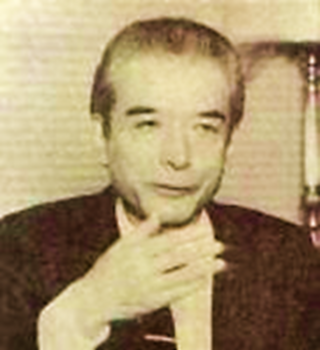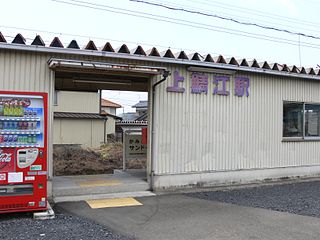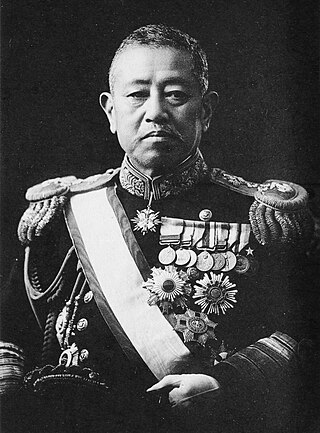
The Chūbu region, Central region, or Central Japan is a region in the middle of Honshū, Japan's main island. In a wide, classical definition, it encompasses nine prefectures (ken): Aichi, Fukui, Gifu, Ishikawa, Nagano, Niigata, Shizuoka, Toyama, and Yamanashi.

Fukui Prefecture is a prefecture of Japan located in the Chūbu region of Honshū. Fukui Prefecture has a population of 778,943 and has a geographic area of 4,190 km2. Fukui Prefecture borders Ishikawa Prefecture to the north, Gifu Prefecture to the east, Shiga Prefecture to the south, and Kyoto Prefecture to the southwest.

Fusajirō Yamauchi, born Fusajirō Fukui, was a Japanese entrepreneur who founded the company that is now known as Nintendo. Yamauchi lived in Kyoto, Japan and had a wife and a daughter, Tei Yamauchi, who later married Sekiryo Kaneda.

Kenichi Fukui was a Japanese chemist, known as the first Asian person to be awarded the Nobel Prize in Chemistry.

Keifuku Electric Railroad Co., Ltd. is a railroad company based in Kyoto Prefecture, Japan in operation since March 2, 1942. It is a parent company of Keifuku Bus and Kyoto Bus, and an affiliated company of Keihan Electric Railway, which owns 42.89% of the company stock. The company's stock is traded on the second section of the Tokyo Stock Exchange.

Fukui Station is a railway station in Fukui, Fukui, Japan, operated by West Japan Railway Company and the private railway operator Echizen Railway.

Fukui is the capital city of Fukui Prefecture, Japan. As of 1 July 2018, the city had an estimated population of 264,217, and a population density of 69.2 persons per km2, in 102,935 households. Its total area is 536.41 square kilometres (207.11 sq mi). Most of the population lives in a small central area; the city limits include rural plains, mountainous areas, and suburban sprawl along the Route 8 bypass.

The Mikuni Awara Line is a railway line operated by Echizen Railway in Fukui Prefecture. The line extends 27.8 km from the city of Fukui to Mikuni-Minato station at Sakai with a total of 22 stations. It was operated by Keifuku Electric Railway until 2001; Echizen Railway took over the line in 2003.

The Katsuyama Eiheiji Line is a railway line operated by Echizen Railway in Fukui Prefecture. The line extends 27.8 km from the city of Fukui to Katsuyama with a total of 23 stations. It was operated by Keifuku Electric Railway until 2001; Echizen Railway took over the line in 2003.

The 1948 Fukui earthquake occurred in Fukui Prefecture, Japan. The magnitude 6.8 quake struck at 5:13:31 p.m.(JDT) on June 28, 1948. The quake's hypocenter was approximately 10 km north-northeast of Fukui, in the present-day neighborhood of Maruoka, Sakai City. The strongest shaking occurred in the city of Fukui, where it was recorded as 6 on the Japan Meteorological Agency seismic intensity scale.

Fukui Airport is a public aerodrome located 5.0 NM north of Fukui Station in the city of Sakai, Fukui Prefecture, Japan. It is also referred to as Harue Airport from its location in former Harue town.

The Fukui Railway Fukubu Line is a 21.4 km railway line operated by Fukui Railway in Fukui Prefecture. The line runs from Echizen-Takefu Station in Echizen to Tawaramachi and Fukui-Ekimae stations in Fukui. Although it has its own right-of-way for most of the route, the Fukubu Line runs with traffic as a tram line past Fukui-Shin Station.

Sundome Nishi Station is a Fukui Railway Fukubu Line railway station located in the city of Sabae, Fukui Prefecture, Japan.

Nishiyama-Kōen Station is a Fukui Railway Fukubu Line railway station located in the city of Sabae, Fukui Prefecture, Japan.

Mikuni Station is an Echizen Railway Mikuni Awara Line railway station located in the city of Sakai, Fukui Prefecture, Japan.

Nishibetsuin Station is an Echizen Railway Mikuni Awara Line railway station located in the city of Fukui, Fukui Prefecture, Japan.

Shin-Fukui Station is an Echizen Railway Katsuyama Eiheiji Line railway station located in the city of Fukui, Fukui Prefecture, Japan.

Higashi-Fujishima Station is an Echizen Railway Katsuyama Eiheiji Line railway station located in the city of Fukui, Fukui Prefecture, Japan.
The Labour-Farmer Masses Party was a political party in Japan. It was founded in January 1929 by Mizutani Chozaburo, a former associate of the Labour-Farmer Party leader Oyama Ikuo. Mizutani criticized Oyama Ikuo for being too open towards a merger with the centrist sectors of the socialist movement. The Labour-Farmer Masses Party was largely confined to Kyoto. The party was one of the founders of the United Proletarian Party Front in 1929.

Katō Hiroharu, alternatively named Katō Kanji, was a Japanese naval officer during the Russo-Japanese War and World War I. The first name 'Kanji' was used in his later life after he became famous, likely just before he was promoted to rear-admiral. He served as the Chief of Navy General Staff from 22 January 1929 to 11 June 1930.


















